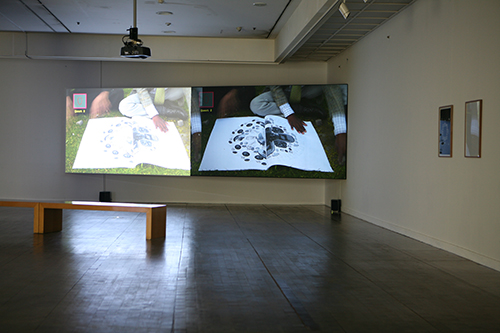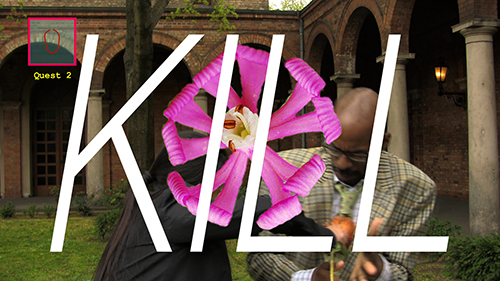Presented at SeMA BLUE: Malfunction Library, Seoul Museum of Art, Seoul, 2014
Video installation, HD, color, sound, 12'06, mixed media, dimensions variable, 2014
Ed. of 3 + II AP
Collection of Seoul Museum of Art
Stone and Donkeys (2014) consists of three video chapters and an epilogue, accompanied by flat and plastic objects. The video appropriates the surface and the structure of video games as well as the literary motif of master and pupil.
In the video, three Donkeys characterised as the Blind, the Dumb and the Assassin appear, and “Stone" as protagonist. The Donkeys are masters of old wisdom from whom Stone learns, as well as her adversaries to finally win against. Each Donkey’s lesson are generic and almost banal phrases of wisdom stating that “not everything you see is truthful,” “listen to the people’s voice” and “a revolution is necessary.” Stone “kills” them through learning and taking over their lines, to proceed to the next level of the “game.”
The names of figures (“Stone” and “Donkey”) have been perceived as metaphors of stupidity in proverbs and literatures of the east and west classics - such as in Pieter Bruegel’s painting The Blind Leading the Blind - while in Stone and Donkeys they incarnate the insightful. The things and places in each chapter seemingly represent European or Asian environments, yet they don’t cease to resist against stereotypes, exposing their cultural and contextual hybridity. The architectural inserts depict sites of assembly, religious and cultural halls, stitched together in a formalistic order. Ultimately these are portrayed as spaces where opinions gather and get debated to become a new knowledge. The fake manuscript appearing in the second chapter is made of digital collage prints bound together; it is a graphic mergence including codex from medieval Europe, buddhist mandalas and plates from Wikipedia on quantum physics. In the installation, the video is double projected onto slightly overlapping black and white screens, resulting into an imperfect perception of each screen. These hybrid and equivocal elements connect or disconnect the scenes, while contradicting and interfering in the narrative which is constructed through the clarity of the image, the text and the voice.
Stone and Donkeys attempts to capture the moment of recognition that 'we don’t know', despite of the easier access to knowledge and the abundance of informations in our contemporary everyday. At the same time, it imagines possibilities of another kind of knowledge in the wilderness of alien iconography, which is not trapped by dualist or black and white paradigm. Here, the knowledge refers to the knowledge as a driving force to intervene and act amongst sociopolitical incongruences, and distinguishes itself from vain discussions or knowledge in an ivory tower.

Photography by Hong Cheolki

Photography by Hong Cheolki
*For each Mandala, figures from Wikipedia have been used.

Quantum Cell Madala*
Two half circles make one Madala: the left one assemble figures from quantum physics, superstring theory and nuclear generation, while the right one the cells and organs of plants and animals. These represent the invisible measures of the globe as well as the minimum unit of a life.

Photography by Hong Cheolki
Galactic Madala*
The Mandala consists of images around the idea of infinitely expanding outer space, galaxies and black holes. It suggests a time and space which deviates from the vision of our globe.
Blank Madala
In the second chapter of Stone and Donkeys the intellectual master, “Donkey 2: the Numb” appears studying blank pages of a fake manuscript. It suggests the notions of an ivory tower, the imaginative knowledge, the act of circumscribing the invisible and learning and unlearning to recognise one’s ignorance.

Photography by Hong Cheolki
Encrypted Manifold Madala*
Voynich Manuscript, dated to the early 15th Century, is written in a hitherto undeciphered language and illustrates a mysterious ecology. On this background, a rendering of Calabi-Yau Manifold is overlaid, implying the folded time and space dimensions in superstring theory.
 copy.jpg)
Photography by Hong Cheolki
Your Emperial Crown
Fleur-de-lis, a traditional emblem in West Europe for aristocracy, phoenix and hibiscus for Korean presidency and the generic structure of a gold crown from ancient Silla Dinasty are pastiched, to form a hybrid crown. This pseudo-relic, a bricolage made of gold cardboard, reflects on the archaic as well as contemporary desires for power.
Cobblestone Pyramid
This minuscule pyramid is made of cobblestones picked from the streets of Berlin. Placed on the top of the crown, it refers to the history of pyramid, which per se is a symbol of power mobilising the mass labor, at the same time to other kind of power manifestations such as the act of judgement through throwing the stone.

<목석과 당나귀들>, 2014
<목석과 당나귀들>은 비디오 게임의 구조와 표면, 무협문학의 사제관계를 모티브로 한 총 3장의 영상 및 영상에 등장한 소품을 재구성한 평면작업과 입체 작업으로 구성된다.
영상에는 맹인, 벙어리, 암살자로 비유되는 세 명의 당나귀와 주인공 목석이 등장한다. 세 명의 당나귀는 목석의 스승이자 각 단계에서 물리쳐야 할 적수이다. 각 장에 등장하는 당나귀들은 “보이는 것이 다가 아니다”, “사람의 말을 귀 기울여 들으라”, “혁명은 필요하다”와 같은 매우 일반적이어서 진부하기까지 한 지혜이자 지식의 선언들을 설파하고, 목석은 앎을 체득하는 방식으로써 그들을 “킬”하고 다음 장으로 넘어간다.
등장인물들의 이름은 동서고금을 불문하고 우둔함의 상징으로 여겨져왔지만, 극중에서 이들은 오히려 현명함의 현신으로 등장한다. 각 장의 사물, 공간과 인물은 일견 유럽적인 혹은 아시아적인 전형처럼 보이면서도 그 무엇도 쉽게 대변하지 않는 혼종성을 지녔다. 또한 2장에 등장하는 필사본은 서양 중세의 암호 필사본, 불교의 만다라, 위키피디아의 양자물리학 도식까지 시대를 아우르는 앎의 도상들을 콜라쥬하고, 디지털 인쇄하여 묶은 것이다. 설치에서 영상은 한 켠이 겹쳐진 백색, 흑색 스크린에 중복 영사되어, 어느 채널로도 전체를 온전히 볼 수 없다. 이러한 위배적인 요소들은 명시적인 이미지, 목소리, 텍스트로 구성된 작품에 틈틈이 등장하며 극을 이끄는 기계장치의 신으로, 각 장면(scene)을 교란시키거나 연결한다.
<목석과 당나귀들>은 지식에 접근이 쉬워지고 많은 정보에 노출된 일상에도 불구하고, 우리는 결국 알지 못한다는 인식의 순간을 포착하고자 한다. 이때 앎이란 현실의 부조리에 개입하고 행동하는 원동력으로서의 앎이며, 탁상공론이나 상아탑의 앎과는 차별된다. 또한 이질적인 도상들이 혼재하는 세계에서 이분법과 흑백논리로 포섭되지 않는 또다른 앎의 가능성을 상상한다.




Video stills
*각 만다라는 모두 위키피디아의 도판을 사용한다.
양자 세포 만다라*
2 점으로 이루어져, 왼쪽은 양자물리학, 끈이론과 핵발전을 키워드로 하며, 오른쪽은 동식물의 세포와 신체기관 도식들을 콜라쥬한 것이다. 세계의 비가시적인 단위 및 생명의 최소 단위를 모티브로 한 만다라이다.
은하 만다라*
무한히 확장된 우주와 은하, 블랙홀 등으로 구성된 만다라. 지구를 벗어난 시공간을 상상한다.
암호화된 다양체 만다라*
배경에 흑백으로 삽입된 15세기 초의 보이니치 필사본Voynich Manuscript은 지구상의 언어로는 해독되지 않는 언어로 씌어진, 정체불명의 생태 도감이다. 이 위에 얹힌 칼라비야우 다양체Calabi-Yau Manifold는 끈이론에서 시공간의 차원이 말려 있는 상태를 도식화한 것이다.
공백 만다라
목석과 당나귀들 2장에서 지식인인 "당나귀 2: 벙어리"는 빈 책장을 연구한다. 지식의 상아탑, 공상적인 지식, 보이지 않는 것들을 그러모으기, 무지를 깨닫기 위한 배움을 상징한다.
당신의 면류관
유럽 귀족 가문의 상징으로 널리 쓰였던 백합 문장, 청와대의 공식 문장과 선덕여왕의 가상적 금관을 뒤섞은 형태이다. 금박 도화지로 어설프게 공작한 왕관은 설치에서 하이브리드적 가짜 유물처럼 등장하며, 권력에 대한 욕망을 성찰한다.
보도석 피라미드
베를린 거리에서 주운 보도석으로 지은 초소형 피라미드. 왕관의 머리 꼭대기에 놓여 노동력으로 축적된 권력의 상징으로서 피라미드와 돌을 던져 심판하는 행위 등 중앙집권적 권력 위에 중첩된 또다른 종류의 권력들을 시사한다.
copyright sylbee kim. all rights reserved